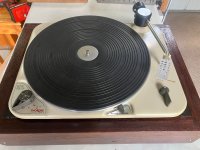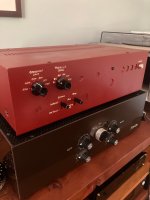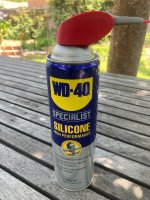The itch first struck some years ago, arriving with the "gift" of some 78s. I tried to ignore it but the itch never quite went away. It recently recurred when I was given a dilapidated Thorens TD135 when helping a relative clean out his recording gear. After all, I had a wee solid state phone preamp that advertised EQ both for RIAA LPs and an alternative EQ for 78s - how could I not get the TD135 working again? After which, those grubby old 78s needed cleaning so that, finally, the stylus could drop into the groove and some music would emerge to scratch that itch. 🙂
Ugh! Less a case of "scratch that itch" than "itch that scratch" 😱 as the wee solid state preamp protested that it was overloading during the louder passages. Hmmmm ... perhaps not surprising with the stylus whizzing along the groove at that speed! On to the bench with the preamp to confirm that yes, indeed, it would readily run out of headroom, especially if the stylus smacked into debris in the groove.
By now I was REALLY itchy, so it was out with the soldering iron and Diego Nardi's "Monophono" preamp design from Sound Practices circa 1996. A dead Sansui AU2900 was gutted and its solid state debris replaced by valves and Diego's variable EQ networks. Once more unto the groove went the stylus and YES! Music! And no more overload! But PLENTY of surface noise, even from "clean" 78s.
The itch, which was worse on some days than others and would not entirely abate, flared red and raw when I read John Fox's article "Record Lubrication has a Significant Effect" at page 36 of the January 1959 edition of Audio magazine (here: https://www.worldradiohistory.com/Archive-All-Audio/Archive-Audio/50s/Audio-1959-Jan.pdf ). Silicone?!?! On a record? Why not! Well, not so much so that excess lube might contaminate the cartridge suspension, but enough to give that old shellac a sheen.
On to the platter with the lubricated disc. On the first play, the stylus collected a LOT of debris - and I thought that I had cleaned that shellac to within an inch of its life - but there were hints of musical glory. On the second play ... aaaah! Lots music with MUCH less surface noise - the difference was not small.
Gene Krupa and his band playing Bolero at the Savoy (Columbia 1941 issue), Sir John Barbirolli with Vaughan Williams' Symphony 5 (probably late 1930s). 🙂🙂 Many more to listen to.

Ugh! Less a case of "scratch that itch" than "itch that scratch" 😱 as the wee solid state preamp protested that it was overloading during the louder passages. Hmmmm ... perhaps not surprising with the stylus whizzing along the groove at that speed! On to the bench with the preamp to confirm that yes, indeed, it would readily run out of headroom, especially if the stylus smacked into debris in the groove.
By now I was REALLY itchy, so it was out with the soldering iron and Diego Nardi's "Monophono" preamp design from Sound Practices circa 1996. A dead Sansui AU2900 was gutted and its solid state debris replaced by valves and Diego's variable EQ networks. Once more unto the groove went the stylus and YES! Music! And no more overload! But PLENTY of surface noise, even from "clean" 78s.
The itch, which was worse on some days than others and would not entirely abate, flared red and raw when I read John Fox's article "Record Lubrication has a Significant Effect" at page 36 of the January 1959 edition of Audio magazine (here: https://www.worldradiohistory.com/Archive-All-Audio/Archive-Audio/50s/Audio-1959-Jan.pdf ). Silicone?!?! On a record? Why not! Well, not so much so that excess lube might contaminate the cartridge suspension, but enough to give that old shellac a sheen.
On to the platter with the lubricated disc. On the first play, the stylus collected a LOT of debris - and I thought that I had cleaned that shellac to within an inch of its life - but there were hints of musical glory. On the second play ... aaaah! Lots music with MUCH less surface noise - the difference was not small.
Gene Krupa and his band playing Bolero at the Savoy (Columbia 1941 issue), Sir John Barbirolli with Vaughan Williams' Symphony 5 (probably late 1930s). 🙂🙂 Many more to listen to.


Attachments
Those old magazines are fascinating to read.
Im up to 1947 to 1948 with Audio Engineering.
Interesting electronic articles, amplifier and some speaker builds.
The Radio kits and parts alone available new is mind boggling. What a time.
The adds are a real kick, for electronic kits and full educational courses.
Sending new pre stamped tube chassis ,transformers and tubes weekly.
For a full course of projects.
The adds seem to really emphasis a lot around 47 when 78 cartridge's really widened the frequency response.
And the micro groove stereo were being pushed a lot more in the adds too.
I had a huge collection of 78s and reading these old magazines really makes me want to do a tube
pre and mono system to hear them.
I had a lot of " fox trots" energetic Jazz from the 30's and 40's
some big band. But really like the era slightly before big band got big.
Those players hit notes that nobody can touch now.
Even the teenage neighbor started finding favorites in my collection.
He got a sense of how even then some of the Jazz was a little rebellious and energetic for the time
Im up to 1947 to 1948 with Audio Engineering.
Interesting electronic articles, amplifier and some speaker builds.
The Radio kits and parts alone available new is mind boggling. What a time.
The adds are a real kick, for electronic kits and full educational courses.
Sending new pre stamped tube chassis ,transformers and tubes weekly.
For a full course of projects.
The adds seem to really emphasis a lot around 47 when 78 cartridge's really widened the frequency response.
And the micro groove stereo were being pushed a lot more in the adds too.
I had a huge collection of 78s and reading these old magazines really makes me want to do a tube
pre and mono system to hear them.
I had a lot of " fox trots" energetic Jazz from the 30's and 40's
some big band. But really like the era slightly before big band got big.
Those players hit notes that nobody can touch now.
Even the teenage neighbor started finding favorites in my collection.
He got a sense of how even then some of the Jazz was a little rebellious and energetic for the time
Interesting. I once tried mineral oil on an old scratchy Ahmad Jamal LP record from the 1950's, it didn't help at all. I'll try silicone.


